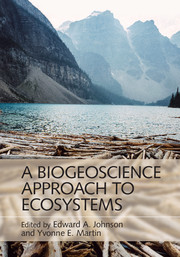Book contents
- Frontmatter
- Contents
- List of contributors
- Preface
- Miscellaneous Frontmatter
- 1 Introduction
- Part I Connecting Ecosystem and Geoscience Processes
- Part II Transport Processes and Conservation Budgets in Biogeoscience
- Part III Coupling Hillslope Geomorphology, Soils, Hydrology, and Ecosystems
- Part IV Coupling Fluvial and Aeolian Geomorphology, Hydrology/Hydraulics, and Ecosystems
- 10 Mechanisms of Flow and Sediment Transport in Fluvial Ecosystems: Physical and Ecological Consequences
- 11 Measuring the Hydraulic Landscapes of Stream-Dwelling Invertebrates for Ecological Research
- 12 Salt Marsh Ecosystems: Tidal Flow, Vegetation, and Carbon Dynamics
- 13 Coastal Dunes and Vegetation Dynamics
- 14 Biogeomorphic Ecosystems within Stressful and Disturbed Environments: A Focus on Termites and Pioneer Plants
- Index
- References
14 - Biogeomorphic Ecosystems within Stressful and Disturbed Environments: A Focus on Termites and Pioneer Plants
from Part IV - Coupling Fluvial and Aeolian Geomorphology, Hydrology/Hydraulics, and Ecosystems
Published online by Cambridge University Press: 27 October 2016
- Frontmatter
- Contents
- List of contributors
- Preface
- Miscellaneous Frontmatter
- 1 Introduction
- Part I Connecting Ecosystem and Geoscience Processes
- Part II Transport Processes and Conservation Budgets in Biogeoscience
- Part III Coupling Hillslope Geomorphology, Soils, Hydrology, and Ecosystems
- Part IV Coupling Fluvial and Aeolian Geomorphology, Hydrology/Hydraulics, and Ecosystems
- 10 Mechanisms of Flow and Sediment Transport in Fluvial Ecosystems: Physical and Ecological Consequences
- 11 Measuring the Hydraulic Landscapes of Stream-Dwelling Invertebrates for Ecological Research
- 12 Salt Marsh Ecosystems: Tidal Flow, Vegetation, and Carbon Dynamics
- 13 Coastal Dunes and Vegetation Dynamics
- 14 Biogeomorphic Ecosystems within Stressful and Disturbed Environments: A Focus on Termites and Pioneer Plants
- Index
- References
Summary
Introduction
Organisms (fauna, flora and microorganisms) are components of the Earth that respond to but also affect their geomorphic environment. Indeed, most of Earth's landscapes are defined, at least partly, by biota (Goudie and Viles, 2010; Corenblit et al., 2011; Holtmeier, 2015; Phillips, 2016). The Earth Critical Zone (ECZ; i.e., “heterogeneous, near surface environment in which complex interactions involving rock, soil, water, air, and living organisms regulate the natural habitat and determine the availability of life-sustaining resources”; NRC, 2001) that concentrates most of life on Earth supports strong feedbacks between biota and abiota. Here, feedbacks relate to organisms’ effects upon their geomorphic environment and their responses to the modification they induce themselves on their geomorphic environment. The responses of the organisms to the changes of the geomorphic environment concern ecosystems at various levels, from genes to landscape via populations and communities.
Feedbacks between organisms and their physical environment within the ECZ is a focus for geomorphologists, ecologists and evolutionary biologists attempting to establish top-down and bottom-up eco-evolutionary connections between the different levels of ecosystems and their biotic and abiotic components. The goal of this chapter is to exemplify how feedbacks between organisms and geomorphology within stressful and disturbed environments can generate biogeomorphic ecosystems (sensu Balke et al., 2014 and Corenblit et al., 2015b). A biogeomorphic ecosystem is an ecosystem in which organisms and geomorphic components (i.e., surface matter and energy fluxes, landforms and soils) strongly interact and adjust reciprocally. Biogeomorphic ecosystems keep their integrity (form and function) under stressful and disturbed conditions within specific domains of stability from the feedbacks between organisms and their geomorphic environment. Stress is defined here as predictable external constraints which limit the rate of organic production (Grime, 2002); it relates for example to water deficit. A disturbance is defined as any relatively discrete event in time that disrupts ecosystem, community, or population structure and changes resources, substrate availability, or the physical environment (Pickett and White, 1985).
- Type
- Chapter
- Information
- A Biogeoscience Approach to Ecosystems , pp. 456 - 474Publisher: Cambridge University PressPrint publication year: 2016
References
- 1
- Cited by



